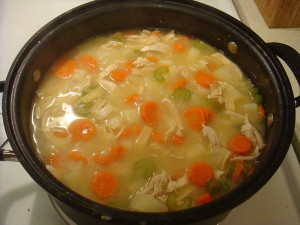When anxiety strikes, you can try talk therapy — or you can try kitchen therapy. A writer who’s done both explains how preparing a stew or roasting a chicken helps him make sense of the world.

Fruit tart with kiwi, peach, and raspberry. Photo: Garry Knight. Source: Wikimedia Commons.
When anxious sadness descends on me, I retreat to one of two rooms in my house. I’m either in the bedroom, hiding under the covers and hoping the world will go away, or I’m in the kitchen adding novel ingredients to old favorite dishes. I am a person with a lot of internal chaos, and in consequence, I try to control my external chaos. I like imposing my will, and when I can’t manage to do that with people or current events, I do it instead with racks of lamb or fruit tarts.
I prefer recipes that are really tactile—anything that requires touching the ingredients. Stuffing a game bird can release a lot of anxiety, and so can mixing up potato salad. I like slathering things: rich marinades on meat, or even just butter on toast. Quantity is comforting, and so is creaminess. I like making a lot of chopped foods that use up my fidget factor, like a chicken hash with melting lumps of foie gras to make it all worthwhile. I can whip up a mean chocolate cake, a variation on one my mother used to make, with lots of kirsch and sour cherries in it. All those jobs that can be so burdensome when I’m in a good mood—endless stirring, for example, or separating eggs, or melting things in a double boiler—become instead, when I’m really stressed, satisfying activities.
In this state of mind, I may get inspired by recipes, but then I need to run free, to try things arranged in different ways. What I like is the feeling that I’m making up the rules, that I’m going with my instincts, that I’m in the moment—and that I’m winning. When it works, and wonderful smells begin to penetrate the house, I get the momentary illusion that I am competent in all aspects of my life and that I can make music of anything. The frightening chaos outside seems temporarily becalmed.

Chicken noodle soup in the making. Photo: Debs. Source: Wikimedia Commons.
I should emphasize that there’s some distinction between what is comforting to make and what is comforting to eat, though there’s plenty of overlap. I love eating creamed spinach, for example, and mashed potatoes, and roast beef. And when I’m at my lowest, I crave chicken soup. But when I’m feeling that I can’t quite cope, I don’t tend to make any of those. For me, the comfort of cooking lies in the exploration, while comfort food for eating is essentially repetitive, carrying memories of all the previous times that I’ve had it. When I’m relaxed, the repetition can be rather pleasant; I can think about other things while I put those same old components into a boeuf bourguignonne. But when the purpose of the cooking is to escape other things, I’d rather get preoccupied with putting grapes in dishes where you’d never expect to find them.
I’m a talker, and will burden friends with my tales of woe while I try out my latest purees on them. The father of one of my godchildren, however, is a divine chef who works through feelings of irritation or life stresses by silently making things. The more unhappy he is, the more elaborate his cooking becomes. When I stop by for supper and get a seven-course meal that includes a complicated risotto, elaborately boned fowl and a soufflé, I know that he must be hurting. He’s English and doesn’t talk about feelings. His wife has told me that she can sometimes judge what’s going on inside him better by the care with which he minces garlic than by any more conventional communication.

Easing the pain with a nice fresh batch of cinnamon rolls. Photo: Whitney. Source: Wikimedia Commons.
Another friend of mine does what he calls “panic baking.” This entails choosing a recipe that will involve many ingredients and make a big mess, throwing himself into it and then getting a feeling of great peace when everything is put into the oven. Then he cleans up the mess. Baking, of course, involves closer adherence to recipes than does most of what I do, and he champions the pleasures of putting himself through the paces. For him, the pleasure and release are like what he gets out of exercise, following the set patterns through. For me, the resolution is like what I get out of psychotherapy, trying to work through all the tangled subconscious stuff simply by expressing it.
While I find that cooking is extremely therapeutic, I find that being cooked for is sometimes even more therapeutic. There’s nothing I like less, when I’m feeling bad, than restaurants. I prefer having a person I know make things especially for me. It’s an expression of love that brooks no argument and no exemption. When the World Trade Center fell, I got extremely upset and left New York City to stay with my other half in Minneapolis, where he lives. He made me ice cream. He made me different kinds of ice cream, day after day, and when he was off at work and I was trying to write, I ate that ice cream; and then, when he came home, we ate ice cream together, and somehow the fact of it and the effort of it and the cool reliable flavor of it made me feel again as though the world might be a safe place to live in.
Meanwhile, I invented new recipes for the rest of dinner every night.
And so we got through.











